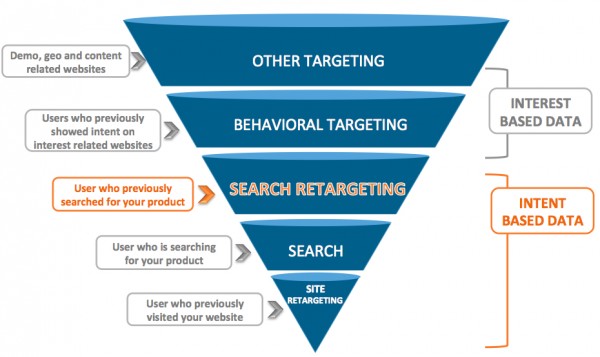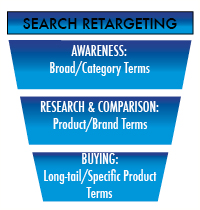Understanding Keywords In Search Retargeting
Now that everyone’s done making their predictions for 2012 (more flying inflatable sharks is mine), it’s time to get back to business. Over the past 18 months, the display industry has seen the dawning of the golden age of search retargeting. The question went from “What is search retargeting?” to “Where can I get it?” […]
Now that everyone’s done making their predictions for 2012 (more flying inflatable sharks is mine), it’s time to get back to business. Over the past 18 months, the display industry has seen the dawning of the golden age of search retargeting.
The question went from “What is search retargeting?” to “Where can I get it?” and finally “How do I take my search retargeting campaign to the next level?” While there are far too many topics to address in one post, let’s take a look at the first, and most important, component: the keyword lists.
Since search retargeting relies heavily on keyword lists to determine which consumers to target and which to ignore, starting the campaign using the right keyword lists makes a world of difference in how fast a search retargeting campaign reaches desired performance.
Many advertisers think that matching their SEM list is the best way to generate a keyword list, and indeed, it’s a good place to start. However, it’s important for marketers to understand that search retargeting is an extension of SEM, and keyword lists must scale beyond SEM for search retargeting campaigns.
Let’s consider the consumer funnel compared to corresponding ad targeting strategies. Interest based targeting is at the top of the funnel and typically powers brand awareness campaigns. As we move down the funnel we come to the mid to lower funnel targeting strategies, which tend to support targeted brand awareness and direct response-based campaigns.

Some SEM Terms Are Too Low In The Funnel For Display
To run a search retargeting campaign, a search retargeting partner needs to cookie a user and then target them again once they find them across their display media.
This means that there could be a gap of minutes, hours or even days between when a user performs a search and when the search retargeting partner actually sees that user again and is able to show them the relevant ad.
Since SEM campaigns target users on the next page following the search, they need to drive them to the advertiser’s page right away. If they don’t, game over. As a result, SEM campaigns tend to target users who are ready to convert in the next few minutes.
Let’s take Best Buy, a large electronics retailer, as an example. An SEM campaign for Best Buy might be targeting the term “Best Buy 50 inch Sony plasma TV sale.” This user is likely to convert in a small window of time, as he/she clearly knows exactly what they’re looking for and even the store they’re looking to buy from.
Conclusion: If a search retargeting company were to target users who searched for this term, they’d be showing an ad to someone who has most likely already converted and would therefore be wasting ad impressions, and more importantly ad dollars.
Search Retargeting Is Designed To Push People Down The Funnel
To run a successful search retargeting campaign, the advertiser needs to target keywords that indicate when a user is in a purchase or consideration mindset, but hasn’t made up his or her mind just yet. As a result, it’s important to target terms that wouldn’t necessarily be included in an SEM campaign due to the example shown above.
Using the example above, a user searching for “plasma TV comparison” or “online plasma TV store” is someone Best Buy should definitely target. While the user might be a week away from converting, Best Buy should get in front of them during the consideration set, so that the brand is top of mind further down the purchasing funnel.
Conclusion: By limiting keywords to a brand’s SEM list, the advertiser might miss out on engaging consumers during the consideration phase, and pushing new customers through the funnel.
Marketers and their partners must work together to prune the advertiser’s SEM list and they must utilize a keyword generation tool that takes into account mid and upper funnel terms. It’s not just a semantic issue. This has ramifications for strategy.
Digital agencies and brand marketers need to be smarter about crafting and researching target terms that might be deemed too mid or upper funnel for an SEM campaign.
The goal of search retargeting is to take users at that stage in their decision-making and drive them to a specific advertiser or product. That means driving them down the funnel, and the right keywords can be the right fuel for the journey.
Opinions expressed in this article are those of the guest author and not necessarily Search Engine Land. Staff authors are listed here.
Related stories
New on Search Engine Land
